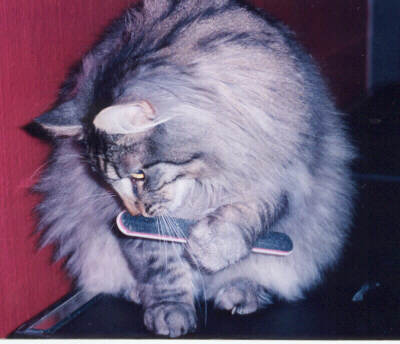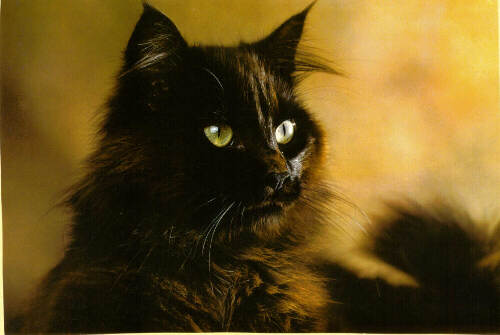
First it has to do with how cats' claws are designed - and as usual when we mess about
with mother nature, we miss some of the reasons for the way things were designed naturally.
Cats' claws are made in layers one covering the other, just as an onion for example,
has layer upon layer - but with the outer layer very smooth.
Unclipped cats' claws are also very smooth on the outside, so that the whole outer claw
layer is a smooth-surfaced sheath, covering the many nesting layers underneath.
If you have ever been scratched by an angry cat with clipped claws, you will know
that the wound tends to be jagged due to the tearing nature of the scratch
with a blunt claw. You'll also know that the wound has a high chance of being
nastily infected. It also is likely to heal with a rather ugly scar.
Altogether a most unpleasant experience.
You may never have been scratched by a cat with intact claws, but if you have,
the cut may have been quite deep, and it probably bled quite a lot. That's because the cut
was made with a razor-sharp edge.
However, the cut will have healed overnight, been straight and not jagged,
and it will have healed cleanly without infection!
WHY?
As you chop accross the cat's claw, when you clip it, you expose the multiple
layers of the claw, just as you do if you chop accross an onion.
These layers are no longer the smooth polished surface of an intact claw, but have cracks and hollows,
and though microscopic in size, that's all that's needed to harbour bacteria, and
establish a place to maintain an unclean environment.
The fact that these claws will go digging in litter, getting further
contaminated, only adds to the problem. By contrast, the smooth and
unclipped claws, stay clean, and harbour no bacteria in the cracks between
the claw layers - as no claw layers are exposed.
So in general, IF you were ever to get scratched by a cat, a clean sharp cut from an intact claw will be the best for you, as although it will bleed more (washing away any bacteria that might have been around), it is a straight clean cut with no jagged edges, it heals quickly and cleanly.
I recently visited a friend who breeds Orientals, and proposed my no-clip idea.
Well, that did not work - it seems her cats' claws carry on growing till they are so long that they
are a problem to the cat. In such a case, I suppose claws need clipping.
It seems odd to me that we have bred cats so extreme as to need this, however.
Norwegian Forest Cats neither need it, nor benefit from it. There are other
reasons not to clip *their* claws:
Wegies come down trees head-first, and the only time one of my cats accidentally
got his claws clipped (by an overzealous groomer unaware of the potential damage
which could result), the cat in question (Odin - see his home page) came headlong down a tree
in the usual Wegie style, head first, found that his claws unexpectedly failed to function
as intended, and he sprained both front legs badly in the resultant fall.
He was a 17 lb cat, so the damage was quite severe. He recovered, and I learned to
warn grromers and vets not to automatically clip Wegie claws!
Another reason to keep the claws intact, is that of ensuring the cats know how much to retract their claws,
to fully sheath said talons. With claws always intact, they learn from kittenhood, just edxactly how long their claws are,
and how much to pull them in, in order to avoid hurting anyone. (Cats are creatures of habit after all.)
When they are young kittens, I train mine to know when their claws are too far out so that they might hirt - cat's do not intend to hurt
at this stage, and may do so inadvertently. I find that saying "ouch!"
loudly, gets the point accross, that I was hurt (I exaggerate a tiny clawing into a major issue here for
training purposes). I also as need, push the claws back into their retracted positions,
saying "Gently!" as I do so. This is such easy training to do, the kittens pick up on it right away. As I say, they do not mean to hurt, so only
need an indiation of what claw position is needed with humans in play.
They use a bit more claw extention for playing with their furry friends or with toys. It's just a matter of pointing out that we humans
have rather naked and sensitive surfacing!
I imagine that with variable-length clipped claws, cats would not learn to habitually
retract their claws fully, as mine do. Full retraction would feel different on different days, and
one gets no benefit from the fact that cats are creatures of habit - you cannot deveop
a habit when the claws are always some unpredictable and inconsistent length?
I'm pleased to say no visitor has ever been scratched by one of my enthusiastic
fun-loving kitties with their well-trained intact claws. My Grand Ch stud Loki,
was voted best temperament cat ever seen on a Cape Town show - by the All Breeds Cat Club.
He was shown with his claws all intact of course.
I have to wonder whether a cat who *knows* his claws are functional as they were
designed to be, is perhaps better adjusted to life as a laid-back character.
There is perhaps more need for a cat to be apprehensive if it has no idea what stus its claws might be in
as regards defence, from one minute to the next???
Gr.Ch.Furry Boots LOKI

Perhaps one day a judge will somehow notice my cats' claws have sharp points. But I doubt it!
They are so well sheathed, and so accurately sheathed, that one only feels fur.
I notice that the dexterity with which my cats manipulate toys (theirs or mine!)
is quite remarkable - Loki will extend a single claw, leaving the others of that paw fully sheathed,
and delicately lift a tiny bit of meat I offer, turn the claw, and eat the item,
never letting a sharp claw near my fingers.<<
I think it takes practise to do such things accurately, one claw at a time, and that Loki
manages because his claws have never been clipped -
Do you think he could do this if he did not know exactly how much to move each claw to fully sheath it, or to manipulate something with it???